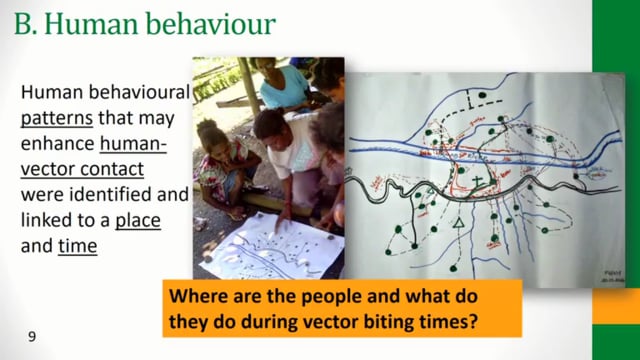Last Updated: 18/02/2022
Australian Centre for Research Excellence in Malaria Elimination (ACREME)
Objectives
In the Asia-Pacific region, the Centres of research excellence (CRE) will work to accelerate progress towards malaria elimination. Through surveillance, to develop better ways to monitor malaria transmission and discover who is infected, and to track movement of malaria parasites and spread of drug resistance. Diagnosis, to develop and test new, more sensitive ways of detecting malaria. Treatment, to fast track development of new antimalarials, and improve access to ensure all infected people get highly effective drugs.
Developing a multiscale model combining both within-host and population level information to predict the emergence and spread of antimalarial resistance
Novel serological markers for surveillance of both P.vivax malaria exposure and immunity
Understanding RTS,S immunity to inform vaccine implementation and design an improved pre-erythrocyte stage vaccine to facilitate malaria elimination
The cost-effectiveness of molecular epidemiology to inform malaria control program decision-making: a scoping exercise
Paving the way for universal radical cure
Development of a novel mouse model of artemisinin resistant malaria to screen and prioritize antimalaria drugs effective against artemisinin-resistant parasites
Enhanced geospatial surveillance for identifying malaria transmission hotspots using antenatal screening in PNG
Development of a high-sensitivity reader for improving use of malaria RDTs
Building capacity for an innovative amplicon deep sequencing tool to genotype Plasmodium infections for improved surveillance
The impact of a malaria infection on G6PD activity (MAGY)
Functional human antibodies that target P. falciparum gametocytes to reduce malaria transmission
Field evaluation of a Point-of-Contact device for P. falciparum malaria serosurveillance
Investigating the transmissibility of artemisinin-resistant P. falciparum and the effect of artesunate on gametocyte production
Use of proteomics as a platform for evaluating new biomarkers for improving diagnosis of Plasmodium vivax for the purpose of malaria elimination
Age-dependent diversity of innate immune responses in malaria
How best can we detect the hidden splenic parasite biomass in human Plasmodium infection? Part 1: peripheral blood
Characterizing antibody responses to PfEMP1 as biomarkers of severe and uncomplicated malaria in Papua New Guinea
Serological exposure markers for P. vivax in pregnant women
Optimal geospatial design of malaria surveillance programs
Understanding the role of polymorphisms in vaccine escape to guide malaria vaccine development and implementation
Investigating antibody responses to mosquito salivary antigens across the Asia Pacific to advance novel malaria surveillance strategies
Validating molecular and serological tools for detecting hidden reservoirs of Plasmodium infections in Papua New Guinea
Investigating asymptomatic transmission of malaria parasites in the Madang province of Papua New Guinea
Assessing the early development of functional antibody responses and target antigens in controlled human malaria infection to inform vaccine development
Spatial imaging and transcriptomic analysis of immune cells and malaria parasites in Plasmodium-infected human spleens
Indentification of antibody targets and mechanisms associated with duration and spontaneous clearance of subclinical Plasmodium vivax infection
Methodological comparison of P. vivax genotyping approaches for molecular surveillance within the ACREME network
Artificial Intelligence-based drug resistance screening of malaria parasites using ‘Read Until’
Understanding cross-reactive antibodies in children without documented exposure to malaria
Characterizing the longitudinal immune response to salivary antigens of Southeast Asian mosquito vectors of malaria, with a human challenge model
Estimating disease prevalence in a sentinel site catchment population to complement case-based suveillance and develop decision-making tools
MinION sequencing for rapid detection of imported P. vivax cases
Collection of cells to isolate monoclonal antibodies to placental malaria antigens
Web-based interactive tool to improve decision-making for malaria elimination in Vietnam
Utilising community malaria volunteers to expand molecular and serological surveillance of malaria in pre-elimination settings
A statistical framework for identifying sufficient data to infer a total parasite biomass
Defining the antigenic diversity of Plasmodium vivax apical membrane antigen to inform vaccine development
Genomic surveillance for emerging Plasmodium knowlesi malaria
Predicting malaria transmissibility in a near elimination setting and identifying key drivers for malaria elimination
Determining the degree of infant exposure to primaquine through colostrum and transitional breast milk – opening the gateway to early postpartum radical cure to curb maternal Plasmodium vivax relapse
Hybrid genome assembly and annotation of Plasmodium vivax from the Asia-Pacific region
Feasibility assessment of the use of Optical Mark Recognition around Vivax Malaria surveillance
Jan 2017 — Dec 2022
$1.17M


